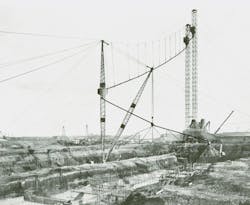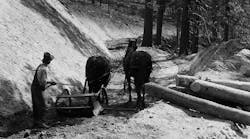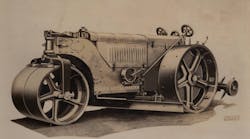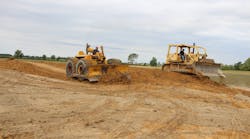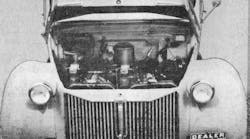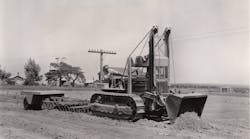In the early 1900s, the need arose for machines capable of pouring large concrete slabs, while also handling the increased amount of concrete produced by more efficient mixers. Cranes of the day were quite limited in lifting range and capacity and not capable of handling the work, and a successful concrete pump would not be invented until 1927.
Several manufacturers developed a means to do this work. Although details varied, the basic system consisted of one or more towers designed and strategically situated on a job site to distribute the most concrete to the widest area with the least machinery, the least movement of equipment, and the shortest haul from the mixer to the tower. Concrete was raised in a bucket, inside the tower, to a hopper that discharged the material into a chute system, which took it to the pour. Concrete had to be properly mixed to prevent it from separating or clogging the chutes, and the operator had to keep the mix moving steadily.
The chute system usually consisted of a head chute mounted to the tower, one or more line chutes, and a counterweight chute that was suspended from a separate boom and could pivot at the end of the line chute(s) to provide a larger radius for concrete placement. Towers were sometimes used only with the head or head and line chutes, and in some installations, a separate guy derrick supported the boom chute while suspending the counterweight chute. The exact combination of tower height, hoist bucket, hopper size, and chute type and slope were dictated by job requirements and concrete specifications.
Tower heights of 83 feet seem to have been common, using a 60-foot mast topped by a 23-foot boom, to which the hopper and chute were attached. Some plants could cover a 300-foot radius. The boom for the counterweight chute was mounted to the mast.
A properly designed and operated tower could distribute concrete as fast as the mixer could produce it and could elevate it over formwork, while eliminating the need for trestles and runways otherwise required for carts to take material to the pour. The towers were originally made of wood and were demolished at a project’s conclusion; by 1921, steel towers were promoted for their permanence and reusability.
These often-elaborate plants were rendered obsolete by the advent of mobile, free-traveling cranes in the 1930s. Along with the towers and chutes, Insley also produced all the equipment related to them (except for the mixers) and went on to offer concrete carts, hoppers, and buckets as late as the mid 1960s.
The Historical Construction Equipment Association (HCEA) is a 501(c)3 nonprofit organization dedicated to preserving the history of the construction, dredging and surface mining equipment industries. With more than 4,000 members in 25 countries, activities include operation of National Construction Equipment Museum and archives in Bowling Green, Ohio; publication of a quarterly magazine, Equipment Echoes, from which this text is adapted, and hosting an annual working exhibition of restored construction equipment. Individual memberships are $32 within the U.S. and Canada, and $40 elsewhere. Information is available at www.hcea.net, 419.352.5616, or i[email protected].
